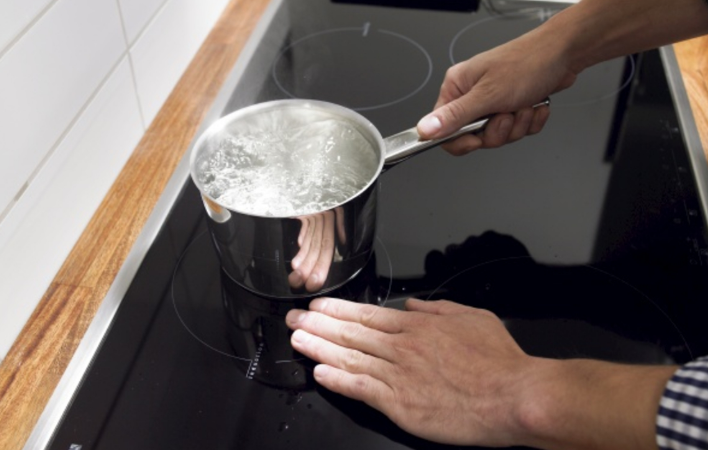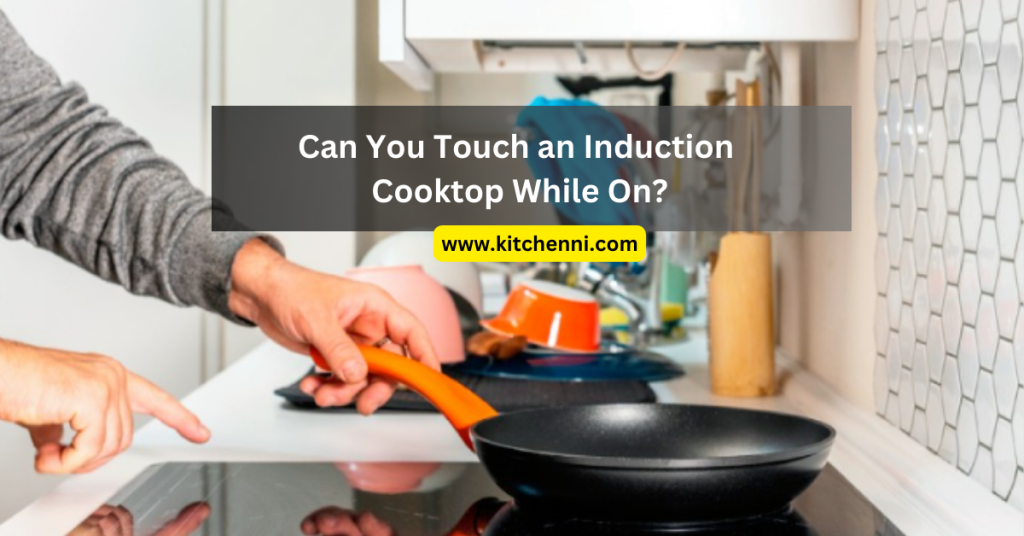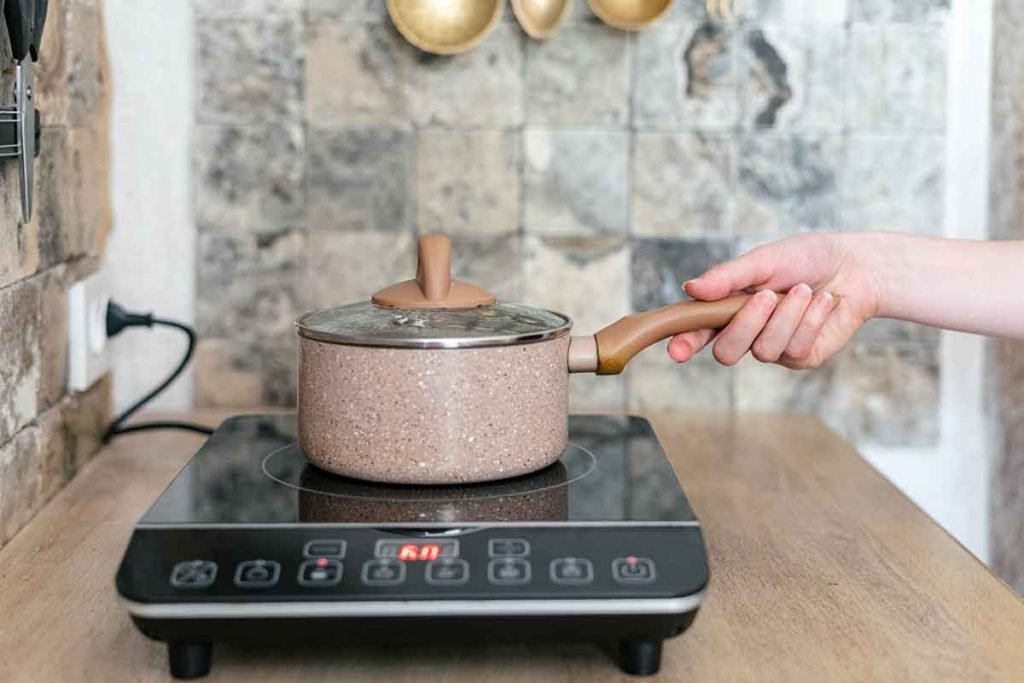Yes, you can touch an induction cooktop while it’s on without getting burned. That is possible because this appliance uses electric current to heat the cookware exclusively. But I don’t subscribe to that school of thought.
Here’s something that most manufacturers don’t disclose to their customers. Induction cooktops can get pretty hot. And I should know that well enough. Before buying my first cooktop, I researched extensively and discovered one thing from most sources: an induction stovetop’s surface doesn’t get hot. But the cookware does. And it leaves the surface quite hot.
Armed with that information, one day, I placed a hand on my cooker after using it. To my utter surprise, it was hot! It was shocking. I didn’t expect that to happen. But I’ve learned better. If you haven’t made the mistake, let me save you from a potentially painful situation.
Does The Surface of An Induction Cooker Get Hot?
Ideally, the surface of an induction cooker shouldn’t get hot. Remember, cooktops are only supposed to transfer heat to the cookware’s bottom. So, if anyone touches an induction hob’s cooking surface, they are not supposed to feel anything. But that’s not always the case.
The surface of an induction stove can get hot. But you can’t blame the heating elements because those don’t generate heat. The culprit in this scenario is cookware. If you use a pot or pan that’s exceptionally good at retaining heat, it will eventually transfer the heat to the cooktop’s surface, making it hot to the touch.
How Hot Does an Induction Cooktop Get?

Ideally. The surface of the cooktop doesn’t get hot. It shouldn’t.
“I was so surprised when I first started cooking with my new induction cooktop. The surface barely gets warm at all, even when I’m sautéing stuff at high heat. My friend Susan didn’t believe me until she tried cooking on it herself.” – Amy Thompson, home chef and induction cooking enthusiast
However, an induction hob can get anywhere from warm to scalding hot, depending on several factors. The first factor that determines how hot your induction cooktop gets is the cookware you use.
Stainless steel and cast-iron pots and pans have outstanding heat retention. So if you use such items to cook on an induction hob, chances are high they’ll make the surface hotter than items made of other materials.
The other factor is cooking time. The longer you cook with an induction hob, the hotter it’s likely to become, especially when the cookware has high heat retention. The hotness level will also be significantly higher when high-temperature settings are involved. Remember, most induction cooktops can reach 643°F, which is pretty hot.
Will The Cupboard Below an Induction Hob Get Hot?
I’ve installed my cooktop on top of a drawer, and here’s what I’ve observed. Sometimes, the drawer gets hot, especially when I use the cooker for a long time or turn up the heat. I’m a big fan of sauteing, so I often do the latter.
The cause of the drawer below my cooker often getting hot is the bottom part of my appliance. If you’ve used induction stoves for long, you know the base can get pretty hot. That is why experts advise homeowners to install a separator plate between an induction hob and any cabinet beneath it.
But a drawer or cupboard below an induction cooktop shouldn’t get hot enough to be unusable. You can still use it to store cooking supplies like utensils, containers, and lids.
Safety Precautions When Operating an Induction Cooker
Induction hobs are fundamentally safer than conventional alternatives like gas and electric stoves. But that does mean you should be reckless with them. You should handle your appliance cautiously to avoid negative outcomes.
Here are a few safety precautions to observe while using an induction stove:
1. Go Through the User Manual
Most reputable cooktop brands provide user manuals to their customers. A typical manual tells a user about the product and its functions.
Before using an induction hob, read its manual from A to Z. The instructions therein will help you install the appliance and operate it correctly. If you don’t read the manual, you might miss important precautions and increase your exposure to issues like scalds and burns. Or, you might operate the appliance incorrectly and miss the golden opportunity to prepare marvelous dishes.
2. Avoid Preheating
Before buying an induction hob, I used a gas stovetop. It wasn’t bad. But more often than not, I had to preheat cookware before the actual cooking began.
Since I’d made preheating a habit, I preheated my skillet for around 10 minutes the first time I used an induction cooktop. I didn’t know that the appliance heats up cookware extremely fast. Due to my ignorance, the cookware became too hot and burned the ingredients the second they landed. It was a bad day. Don’t be like me.
Avoid preheating cookware on an induction hob as much as possible. And if a recipe calls for preheating, don’t do it for more than 2 minutes. Most importantly, never preheat nonstick pans on high heat because it can cause premature deterioration.
3. Do You Have Kids? Use Child Lock
While playing with fire, children start over 20,000 disastrous fire incidents. That is why I don’t let my munchkins mess around with fire. Admittedly, the chances of your kid playing with your induction cooktop and inadvertently starting a fire are pretty low because no open flame is involved. But that doesn’t mean you should let the young ones tamper with the appliance.
Children don’t know how these appliances operate. As such, they may insert objects into available nooks and crannies, which can lead to electrocution. Or, they may accidentally change temperature settings while cooking is underway. To prevent such mishaps, use the child lock as often as possible.
4. If You Have a Pacemaker, Maintain Your Distance
I often advise people with pacemakers to avoid 4 things: cell phones, metal detectors, electronic cigarettes, and INDUCTION COOKTOPS. Why do I include the latter, you wonder? Simple. Induction cookers generate electromagnetic fields, which can interfere with a pacemaker’s functioning.
If you use a pacemaker, avoid cooking with an induction stovetop. And if you must, ensure the appliance is at least 2ft away from you. You might operate it with your smartphone from a distance if it’s a smart appliance.
Summing Up
According to the Burn Foundation, approximately 12,000 burns occur every year. Most of these cases are associated with thermal injuries, which have different causes, including contact with hot surfaces. As we’ve already discussed, induction hobs can get pretty hot. If you don’t want to become a statistic, avoid touching your cooktop’s surface while the hob is on or immediately after cooking.
Besides not touching the cooking surface of an induction hob, I’ve also recommended other safety precautions. Factor them in every time you use your cooktop. You’ll be safer and happier that way.
Common Questions
Is the surface of an induction cooktop safe to touch when turned on?
Yes, the surface of an induction cooktop is safe to touch, even when turned on and actively cooking. Because an induction cooktop doesn’t rely on thermal heat to warm up cookware, the glass surface itself barely gets hot. You can comfortably place your hand directly on the cooking zone and only feel a mild warmth. But don’t touch the cookware, as that can get pretty hot. Some cookware also tends to get the surface hot.
How hot does the surface of an induction cooktop get?
The surface of an induction cooktop only reaches temperatures between 150-200°F when turned on. This is significantly cooler than electric or gas cooktops which can reach over 600°F. The cookware is what gets hot, not the cooktop itself.
Can you burn yourself touching an induction surface?
It is very unlikely you would burn yourself by touching the surface of an induction cooktop, even one that is turned on. Because the temperatures remain so low, the risk of burns is minimal. However, touching hot cookware on the induction surface may cause burns.
Is it safe for kids to be near an induction cooktop?
Yes, induction cooktops are a safer choice if you have kids in the home. Because the surface stays cooler, children are less likely to burn themselves by accidentally touching the cooktop. You still need to supervise kids around any cooktops of course. However, induction surfaces pose minimal risks of burns.



